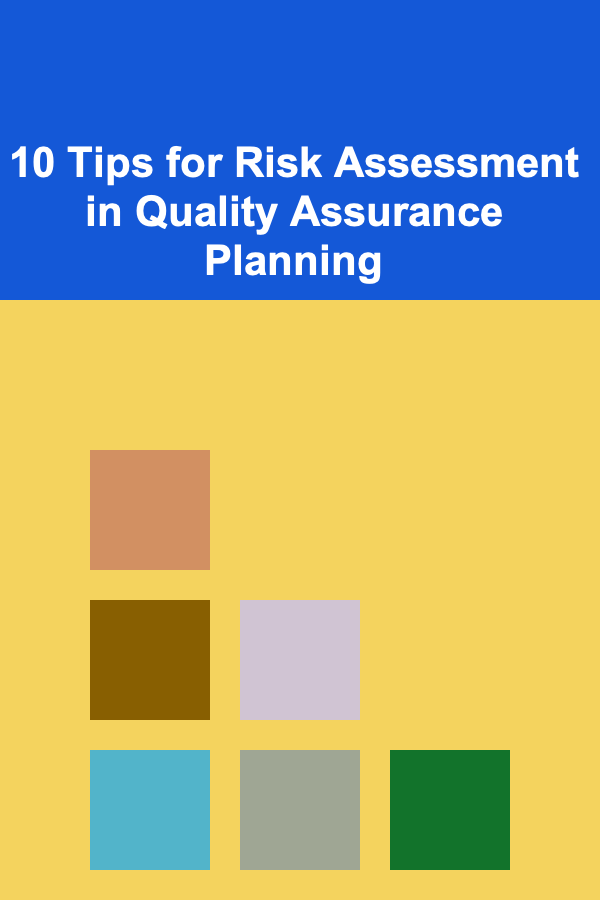
10 Tips for Risk Assessment in Quality Assurance Planning
ebook include PDF & Audio bundle (Micro Guide)
$12.99$8.99
Limited Time Offer! Order within the next:

Quality assurance (QA) is a vital component of any business that delivers products or services, particularly in industries like software development, manufacturing, healthcare, and more. The purpose of QA is to ensure that the output meets the highest standards of quality and performs as expected. One of the most critical aspects of effective QA is risk assessment. Risk assessment helps organizations identify, evaluate, and prioritize risks that could affect the quality of the product or service, ultimately helping prevent failures and improve overall performance.
This article outlines 10 essential tips for effective risk assessment in quality assurance planning. These tips will provide a comprehensive understanding of how to approach risk management in QA, along with strategies to minimize and manage risks throughout the project lifecycle.
Understand the Scope of the Project
Before diving into the risk assessment process, it is crucial to thoroughly understand the scope of the project. This includes the specific requirements, deliverables, stakeholders, and timelines. A clear understanding of the project's scope allows you to identify potential areas where risks could arise, whether related to product quality, timeline, or external factors.
How to Define Project Scope:
- Stakeholder Discussions: Collaborate with project stakeholders to define goals, constraints, and success criteria.
- Document Requirements: Ensure that all requirements are documented and validated by all relevant stakeholders, including customers and internal teams.
- Clarify Deliverables: Be clear about the expected deliverables and their quality standards.
A well-defined scope will guide the risk assessment process, helping you pinpoint areas that require attention and focus.
Identify Potential Risks Early
Risk identification is the first step in the risk assessment process. It involves understanding all possible risks that could affect the project's ability to meet its quality objectives. The earlier you identify risks, the better positioned you will be to develop effective mitigation strategies.
How to Identify Risks:
- Brainstorming Sessions: Gather your team and other stakeholders for brainstorming sessions. This can help uncover both obvious and hidden risks.
- Historical Data: Review previous projects and lessons learned to identify recurring issues or risks that were not adequately addressed.
- Risk Categories: Consider risks across different categories such as technical, operational, financial, legal, or external environmental factors.
The goal is to create a comprehensive list of all potential risks, ensuring that no critical factor is overlooked.
Prioritize Risks Based on Impact and Likelihood
Once risks are identified, the next step is to evaluate and prioritize them. Not all risks carry the same weight; some are more likely to happen, while others could have a far more significant impact if they do occur. Prioritizing risks helps focus resources and attention on those that pose the greatest threat to quality assurance and project success.
How to Prioritize Risks:
- Risk Matrix: Use a risk matrix to assess each risk's probability and impact. Risks with high likelihood and high impact should be prioritized first.
- Severity Scoring: Assign severity scores based on factors like cost, timeline delays, and potential harm to the reputation or safety of the organization or stakeholders.
- Cost-Benefit Analysis: Consider the cost of mitigating each risk and weigh it against the potential consequences of not addressing it.
A structured approach like a risk matrix helps you make objective decisions about which risks deserve immediate attention and which can be monitored or deferred.
Involve All Stakeholders in the Risk Assessment Process
Effective risk assessment requires the involvement of all stakeholders, including project managers, quality assurance teams, developers, and external partners. By involving everyone in the risk assessment process, you gain different perspectives and insights, which can lead to a more accurate and comprehensive identification of risks.
How to Involve Stakeholders:
- Interviews and Surveys: Conduct interviews with key stakeholders to understand their concerns and risks from their perspective.
- Collaborative Meetings: Schedule regular risk review meetings with all stakeholders to discuss and review identified risks.
- Cross-Functional Teams: Form cross-functional teams that include members from various departments to ensure that risks are considered from all angles.
By involving all stakeholders, you ensure that risks are comprehensively evaluated and managed, and that there is consensus on how to address them.
Establish a Risk Management Plan
A risk management plan is a detailed strategy that outlines how identified risks will be managed throughout the project. This plan should include mitigation strategies, contingency plans, timelines, responsible parties, and monitoring processes. Establishing a risk management plan ensures that the team is prepared to respond to risks quickly and efficiently.
Key Elements of a Risk Management Plan:
- Risk Mitigation Strategies: Define the actions that will be taken to reduce the likelihood or impact of each risk.
- Contingency Plans: Outline alternative actions in case risks materialize.
- Assign Responsibilities: Assign team members who will be responsible for managing and monitoring each identified risk.
- Timeline for Mitigation: Set clear timelines for mitigating or addressing risks.
A solid risk management plan not only mitigates the impact of risks but also gives the project team a structured approach to handle unexpected challenges.
Use Data and Analytics to Inform Risk Assessment
Data plays a crucial role in risk assessment. By analyzing historical data, project metrics, and trends, you can make more informed decisions about potential risks. Leveraging data helps to identify patterns that might not be immediately obvious and provides a solid foundation for risk assessment.
How to Use Data:
- Historical Data Review: Analyze past projects for trends and recurring issues that might point to specific risks.
- Predictive Analytics: Use predictive models and algorithms to assess the likelihood of certain risks based on historical data and industry trends.
- Real-time Monitoring: Use real-time data to monitor the project's progress and identify emerging risks before they escalate.
Data-driven insights will help you to more accurately assess risks, ultimately leading to better decision-making.
Develop Contingency Plans for High-Risk Scenarios
No matter how well you plan, there will always be some risks that are unavoidable or out of your control. It's essential to develop contingency plans for these high-risk scenarios so that you can quickly pivot and minimize damage if these risks materialize. Having a contingency plan in place can reduce the time it takes to respond and can help keep the project on track.
How to Develop Contingency Plans:
- Scenario Analysis: For each high-risk scenario, outline the potential impacts and develop a clear, actionable plan for how the team will respond.
- Alternative Strategies: Ensure you have backup strategies for critical processes or systems that are at high risk.
- Resource Allocation: Plan how resources (time, budget, personnel) will be reallocated if a contingency plan needs to be activated.
Having well-thought-out contingency plans ensures that your team remains flexible and prepared for the unexpected.
Monitor Risks Continuously Throughout the Project
Risk management does not end once the project begins. Risks evolve over time, and new risks can emerge as the project progresses. Continuous monitoring ensures that you can detect potential issues early and take corrective actions before they become significant problems.
How to Monitor Risks:
- Regular Risk Reviews: Schedule regular risk review meetings to assess the status of identified risks and any new risks that may have emerged.
- Key Risk Indicators (KRIs): Establish key performance indicators to track the progress and impact of each identified risk.
- Feedback Loops: Encourage open communication and feedback from the project team, stakeholders, and other involved parties to identify emerging risks.
By continuously monitoring risks, you can adapt your risk management strategies and ensure that quality assurance remains on track throughout the project.
Create a Risk Documentation System
Maintaining a detailed record of all identified risks, mitigation actions, and outcomes is critical for ongoing risk management. A risk documentation system ensures that risks are tracked throughout the project lifecycle and provides a reference for future projects. This documentation helps you learn from each project and improve your risk management processes over time.
Key Components of a Risk Documentation System:
- Risk Log: Maintain a detailed log of each identified risk, including its status, likelihood, potential impact, and mitigation actions.
- Risk Reports: Create regular risk assessment reports that summarize the current risk landscape and any changes.
- Lessons Learned: After the project is completed, document lessons learned and share them with the team to improve risk management in future projects.
A robust documentation system allows for transparency and continuity, helping future projects benefit from past experiences.
Foster a Risk-Aware Culture in the Organization
Finally, building a risk-aware culture within the organization is crucial for successful risk management in quality assurance. When employees at all levels understand the importance of risk management and are actively involved in identifying and mitigating risks, the entire organization becomes better equipped to deal with challenges.
How to Foster a Risk-Aware Culture:
- Training and Awareness: Provide regular training on risk management practices to help employees identify and manage risks effectively.
- Encourage Proactive Risk Reporting: Encourage all team members to proactively report potential risks, no matter how small they may seem.
- Recognition and Reward: Recognize and reward employees who contribute to effective risk management efforts.
A culture that prioritizes risk awareness can lead to better decision-making, improved product quality, and reduced project failures.
Conclusion
Risk assessment in quality assurance planning is a continuous process that requires thorough preparation, collaboration, and ongoing monitoring. By following the tips outlined in this article, organizations can not only identify and manage risks more effectively but also enhance the overall quality of their products or services. The goal of risk assessment is to ensure that risks are minimized or mitigated in such a way that they do not hinder the achievement of quality objectives. With the right approach, risk management can be a powerful tool for delivering high-quality results in any project.
Reading More From Our Other Websites
- [Home Staging 101] How to Use Lighting to Enhance Your Home's Features
- [Home Pet Care 101] How to Give Your Dog a Stress-Free Bath: Tips & Tricks for a Happy & Clean Pup
- [Organization Tip 101] How to Review and Learn from Past Travels for Better Planning
- [Organization Tip 101] How to Install New Stair Treads: Tips for a Smooth Finish
- [Home Space Saving 101] How to Use Mirrors to Create the Illusion of More Space in Your Home
- [Organization Tip 101] How to Create an Emergency Preparedness Paperwork Kit
- [Personal Care Tips 101] How to Make Facial Cleanser a Key Part of Your Self-Care Routine
- [Home Storage Solution 101] How to Implement Laundry Storage Organization Ideas for a Tidy Space
- [Polymer Clay Modeling Tip 101] FIMO Clay Troubleshooting: Common Mistakes and How to Fix Them
- [Personal Care Tips 101] How to Use Hair Gel for Curly Hair to Define Curls

DIY Organic Gardening and Pest Control: Natural Solutions for a Thriving Garden
Read More
How to Use Technology to Simplify Donation Management
Read More
How to Get Rid of Dark Circles Under Your Eyes: A Comprehensive Guide
Read More
Boosting Energy Levels During Weight Loss: A Comprehensive Guide
Read More
How to Use Typography Effectively on Wine Bottle Labels
Read More
How to Prep Your Pet for Holiday Travel: A Checklist
Read MoreOther Products

DIY Organic Gardening and Pest Control: Natural Solutions for a Thriving Garden
Read More
How to Use Technology to Simplify Donation Management
Read More
How to Get Rid of Dark Circles Under Your Eyes: A Comprehensive Guide
Read More
Boosting Energy Levels During Weight Loss: A Comprehensive Guide
Read More
How to Use Typography Effectively on Wine Bottle Labels
Read More